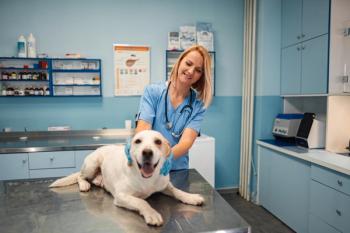
Diagnosing and treating hypertension (Proceedings)
Hypertension may be the most under diagnosed systemic illness affecting companion animals.
Hypertension may be the most under-diagnosed systemic illness affecting companion animals.
Blood pressure elevations are commonly divided into primary and secondary hypertension. Primary hypertension is the result of an imbalance in the relationship between cardiac output and systemic vascular resistance. Although more than ninety percent of all human hypertension cases are primary, the exact cause of this imbalance is not well understood. Secondary hypertension is an increase in blood pressure that occurs as a consequence of another systemic disease or drug. While relatively uncommon in humans, secondary hypertension is believed to account for most cases of canine and feline hypertension. This is important since it allows us to focus our screening efforts on a specific group of patients who are at high risk of hypertension. (Table 1)
Definition
Systemic hypertension is commonly defined as a blood pressure greater than 150/95 mmHg on three separate visits in a patient that demonstrates no clinical signs directly attributable to the blood pressure elevation or a single reading of greater than 150/95 mmHg in a symptomatic patient.
Table 1. Conditions that are commonly associated with hypertension
- Hyperadrenocorticism
- Renal disease
- Thyroid disease
- Diabetes mellitus
- Hepatic disease
- Drugs: erythropoietin, phenylpropanolamine, others
Uncommon conditions: Polycythemia, pheochromocytoma, hyperaldosteronsism (hyperaldosteronism?), chronic anemia
Consequences
Patients with mild increases in blood pressure only show signs attributable to the underlying disease process. As the hypertension worsens, specific organs are damaged:
- Kidney - Glomerular and tubular damage.
- Eye - Retinopathy and choroidopathy (retinal edema, tortuous vessels, hemorrhage and retinal detachment).
- Heart - Cardiac hypertrophy (murmur, arrhythmia, and gallop rhythm).
- Brain - Hypertensive encephalopathy (ataxia, depression, and seizures).
Measurement
The actual measurement of blood pressure requires the catheterization of a suitable artery and the determination of blood pressure with an electronic transducer. Although this is the “gold standard,” it is neither convenient nor practical in the clinical setting. Clinically, we rely on noninvasive indirect estimations of blood pressure using Doppler and oscillometric devices.
Due to its low cost, ease of use, and suitability for use in both cats and dogs, the Doppler flow detector is a commonly used blood pressure measuring device. Doppler units emit ultrasound waves that travel outward until they strike a surface and then they are reflected back to the device. If there is movement, such as blood cells traveling through an artery, the frequency of the returned wave is different than that of the original wave. This change in frequency is amplified by the detector and is heard by the user as a characteristic “swoosh” sound. The only equipment needed is the Doppler flow detector, a sphygmomanometer and a selection of different sized cuffs. Although systolic pressure is easily obtained, determining diastolic pressure can be challenging or impossible.
An oscillometric blood pressure device works by inflating a cuff around an extremity until arterial blood flow is stopped and then, while slowly deflating the cuff, the unit monitors for pulse waves generated by arterial pulsations. Because they are automated and can determine systolic pressure, diastolic pressure, mean arterial pressure and heart rate, these units are quite popular. Despite their convenience, oscillometric units can significantly underestimate blood pressure when used on cats and small dogs (<10 kg) and should not be used on these patients. Recently, a number of oscillometric units that claim to be optimized in cats have been produced; however, recent studies have produced contradictory information as to whether these units can produce accurate measurements.
Important concepts
Regardless of which blood pressure measuring technology is used, there are four principles that help ensure accurate measurements: Proper cuff selection, consistency of personnel, acclimation of the patient, and repeatability of results. Perhaps the most important factor in attaining accurate and repeatable blood pressure measurements is the selection of a correctly sized cuff. Some veterinary-specific oscillometric units have specially designed cuffs, however for Doppler and most oscillometric units, the width of the cuff should be 30%-40% of the circumference of the extremity. A cuff that is too wide will overestimate blood pressure while a cuff that is too small will artificially decrease values. Stress associated with the office visit can cause profound increases in blood pressure; these effects can be minimized by measuring blood pressure in a quiet area, away from other animals, before other procedures, and only after patients have acclimated to their surroundings. The owner should always be present, and restraint should be kept to a minimum. Pressure measurement should be repeated 4-5 times, and the measurements compared. If there is a significant variation (>10%) the readings should be discarded and the process repeated.
Treatment
Angiotensin converting enzyme inhibitors (ACEI) are generally considered to be the initial drug of choice in treating canine hypertension (Table 2). ACEI exert their effect by competitively inhibiting the conversion of angiotensin I to angiotensin II. Since angiotensin II is a potent vasoconstrictor, systemic vasodilatation occurs when its synthesis is inhibited. Angiotensin II also stimulates the release of aldosterone, which leads to sodium and water retention and thus, an increased blood volume. Lastly, angiotensin II directly stimulates the kidney to retain sodium, which results in an increased blood volume. Enalapril is cleared exclusively by the kidneys while benazepril is cleared by the liver as well. For this reason, benazepril is preferable to enalapril in the treatment of hypertension in renal failure patients.
Angiotensin converting enzyme inhibitors are less effective in treating hypertension in cats. Therefore, calcium channel blockers have become the initial drug of choice in controlling feline hypertension. These drugs work by interfering with the influx of calcium needed for smooth muscle contraction and vascular constriction. Due to its once-a-day dosing, gradual rate of effect and relative low cost, amlodipine besylate is the most widely used anti-hypertensive medication for cats (Table 2). Studies in humans and dogs suggest that when calcium channel blockers are used alone for controlling hypertension, they may worsen renal disease despite significantly lowering blood pressure; therefore, these drugs should not be used as a monotherapy antihypertensive agent in dogs. This effect is thought to be due to calcium channel blocker's preferential dilation of the glomerular afferent arteriole paradoxically resulting in glomerular hypertension. ACEI preferential dilate the efferent arteriole normalizing glomerular pressures and prevent renal damage; therefore, calcium channel blockers should only be used in conjunction with ACEIs when treating canine hypertension. Calcium channel blockers do not appear to cause renal damage in hypertensive cats and are considered safe.
Beta-blockers are useful adjunctive therapy in dogs or cats when the initial anti-hypertensive agent has failed to produce the desired decrease in blood pressure (Table 1). Beta-adrenergic receptors are found in both the heart (B1) and lungs (B2). Blockade of the B1 receptors will slow the heart and lower blood pressure; blockade of the B2 receptors can cause an undesirable bronchial constriction. Therefore, selection of a Beta-blocker should be limited to a B1-selective antagonist such as atenolol.
Stimulation of alpha-receptors on blood vessels causes vasoconstriction leading to an increase in system vascular resistance and elevations in blood pressure. Alpha-blockers selectively antagonize these receptors resulting in vasodilatation. Prazosin, a potent alpha inhibitor, has successfully been used as an adjunctive treatment for canine hypertension (Table 2). It's use in cats for this purpose is not recommended.
Drugs that antagonize aldosterone may protect the heart, brain and kidneys from the harmful effects of hypertension. Although inhibition of aldosterone causes only a mild decrease in blood pressure, it may protect against hypertension-induced fibrosis of these target organs. While this information is preliminary, hypertensive patients may benefit from the use of spironolactone as an adjunctive treatment (Table 2).
Goals
The goal of treating hypertensive patients is to gradually lower systolic pressure to less than 170 mmHg. In the initial stages of treatment, monitor the patient regularly but avoid large adjustments in medications. Changes in dose and drugs should only be made every two weeks unless the patient's condition deteriorates. Once the patient's systolic pressure has been regulated, it should be rechecked every three months, and complete blood count and serum chemistry should be checked twice a year.
Table 2. Commonly used antihypertensive medications and their dosages
Drug
Class
Canine Dose
Feline Dose
Enalapril (Enacard, Merck) ACE inhibitor 0.5–1.0 mg/kg q12–24h, PO 0.25-0.5 mg/kg q12–24h, PO Benazepril (Lotensin, Novartis) ACE inhibitor 0.25-0.5 mg/kg q12-24h, PO 0.25-0.5 mg/kg q12-24h, PO Amlodipine (Norvasc, Pfizer) Ca++ channel blocker 0.05–0.2 mg/kg q24h, PO 0.625–1.25 mg/cat q24h, PO Atenolol (Tenormin, AstraZeneca) Beta Blocker 0.25–1.0 mg/kg q12–24h, PO 6.25-12.5 mg/cat q12-24h, PO Metoprolol (Lopressor, Novartis) Beta Blocker 0.5-1.0 mg/kg q 8-12h, PO 2.0 – 15.0 mg/cat q8h, PO Prazosin (Minipress, Pfizer) Alpha Blocker 0.5–2.0 mg/dog q12h Not Recommended Spironolactone (Aldactone, Serle) Aldosterone inhibitors 1.0-2.0 mg/kg q 12h, PO 1.0 mg/kg q 12, PO
Newsletter
From exam room tips to practice management insights, get trusted veterinary news delivered straight to your inbox—subscribe to dvm360.






